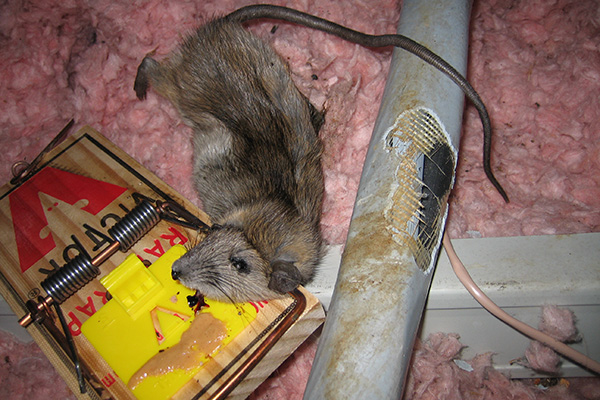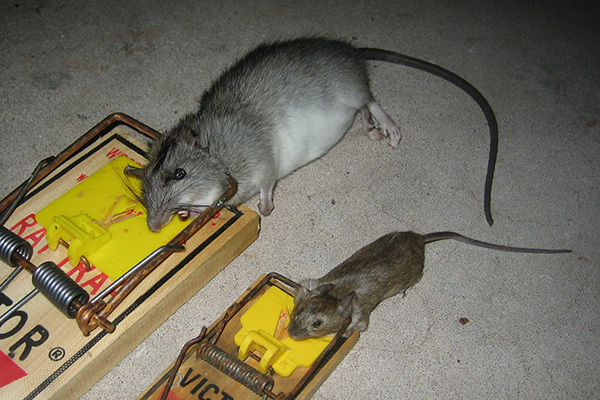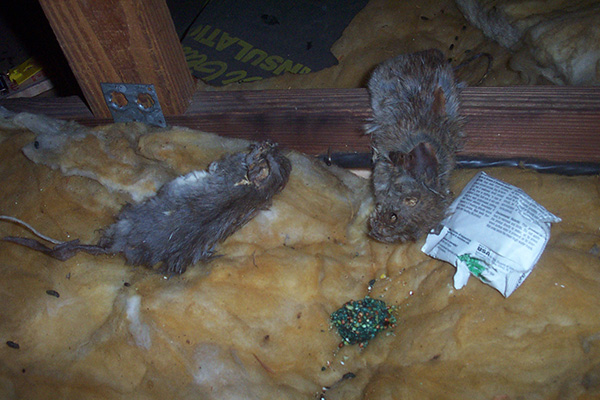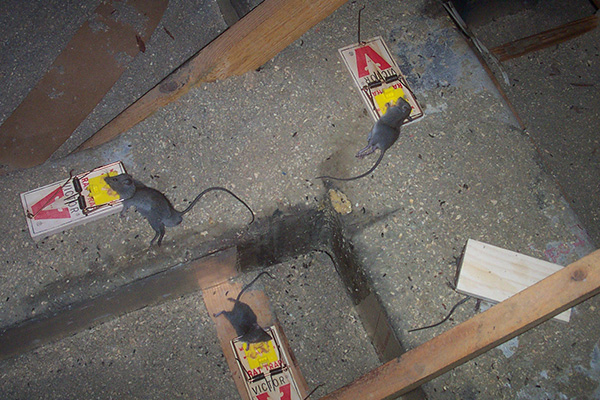- info@animalatticpest.com
- Call - we service 300 locations

Mouse Bait - What is the Best Bait to Catch Mice?
Mice are comparatively easy to trap with snap traps, because they are curious and explore a bit, and are generally fearless. Many types of traps work, but the old standard wooden snap traps are actually the most effective. Just spread some peanut butter on the trip pan. However - bait is actually of least concern. You actually don't need any bait at all. You will have far more success if, before you even start mouse trapping, you seal shut every possible entry hole using steel mesh, which mice are unable to chew through. This first step is by far the most important thing, and the only crucial thing you must do for permanent mouse control. Once that is done, catching the mice is a cinch, regardless of bait. Once the building is sealed, and the mice are trapped inside, set at least a dozen or more snap traps in the attic, on areas of mouse activity (look for droppings and trails in the insulation). You actually don't need bait, but it does help so bait with peanut butter. That's all you really need. Sure, chocolate, or slim jims, or pineapple, or pretty much any food will work. But since peanut butter is easy to apply and works as well as anything else, that's what I go with. But remember, setting some mouse traps with peanut butter randomly in the house or attic will catch a few mice, but not all of them, and the problem will last as long as you have open holes leading into your house. Read more about mouse trapping for tips and proper techniques.
Mouse Bait - What is the Best Bait to Catch Mice?
Peanut Butter is Easy to Use
Just smear some peanut butter on the trip pan. They have to lick it off and spend a little time on it, and will trigger the trap.
Use these Wooden Traps with Yellow Pan
These wooden traps are the best, for both rats and mice. The brand is Victor, and the ones with the yellow trip pan are the most effective.
Don't Use Poison!
Some people call mouse poison "mouse bait". If that was what you were searching for, read all of the reasons mouse poison is ineffective.
Information About Mouse Bait - What is the Best Bait to Catch Mice?
Once there are already mice in your home, the only way to get rid of them is by trapping and removal. Exclusion is almost never used for mice like it is with other wildlife because the animals are unlikely to do well in a new location. This is part of the reason experts prefer to use lethal traps to take care of mice. When setting up the mouse traps in your attic or wherever the animals are, you will need to think about which bait to use, but a few other things are important as well.
Pick Your Ideal Bait
There are a range of baits that mice will like but peanut or nut butter is among the most popular. You probably already have these in your house and they are sticky enough to stay on the trap with ease. You only need to place a small quantity on the trap to attract the mouse and it works well. You can also just put down whole nuts, caramel corn, or peanut oil. Other baits that can work well include hot dog slices, bacon, cheese, molasses, bread and butter, marshmallows, beef jerky, chocolate, raisins, dried fruit, and gum drops.
You can also try using bait that isn’t food items. Mice, particularly pregnant females, are frequently looking for nesting materials. In this case, things like yarn, fabric strips, cotton balls, and pieces of string can work well.
Remove Other Food Sources First
While all of the above foods work well as mouse bait, there is an important caveat to remember. If the mice have access to another food source, they won’t care what type of bait you put on the trap if it isn’t as good. If, for example, you leave out dog food or spilled nuts in your kitchen, a mouse isn’t going to try to get the bread and butter on the trap. Because of this, you need to make sure that you have removed all other food sources for the mouse before setting up the trap. This way, the rodents will be forced to opt for the food on the trap and be caught. Don’t think of this as extra work since you should be getting rid of these potential food sources anyway. If they are left out, you will attract more mice and other wildlife in the future and have to repeat the process of catching them.
Seal Up The Area First
In addition to getting rid of the other food sources before setting the trap with bait for the mice, you also need to seal up the area. This means closing up whatever entry point the rodent used to get into the space, whether it is a gap by your vents or a hole in the siding. As with cleaning up the food, this is something you need to do anyway if you want to prevent pests from entering your home in the future. If you don’t seal up the entrances, you will have to keep trapping mice indefinitely as new ones will keep entering to replace the old ones, particularly if you lay out a tempting spread on the traps.
Choose The Right Type Of Trap
Once you have done the above things, you are ready to set out the bait of your choice on the trap. You should, however, make sure that you chose your trap carefully. Snap traps are the recommended option since they will kill the rodents instantly, making them the most humane method. Glue traps are inhumane and ineffective as they will not always catch the rodent completely and may pull off tufts of fur or even cause the mouse to gnaw off a limb so they can escape. While you may want to try trapping and live relocation, you should know that this will most likely result in death for the mice as well since they will be in an unfamiliar area and mice don’t do well in that type of situation. Since the animals would die anyway, the average person finds it more humane to kill them quickly with a snap trap.
General Trapping Tips
Mice can sometimes be shy around traps so you may want to pre-bait the traps before actually setting them. This involves placing a small amount of the bait on the trap but not setting it so the animal gets used to it and becomes comfortable to it. If you are initially having success with your traps but then notice a drop off despite knowing that there are still mice present, consider switching baits or moving the bait around. No matter the bait you choose to use, remember to check the traps regularly and get rid of any bait that is missing or becomes moldy. You can also hire a professional to take care of removing the mice for you as they will already have the traps and only have to get the bait.
The Bottom Line
Mouse Bait - What is the Best Bait to Catch Mice? Remember, the only thing that matters is that you seal the house shut. After that, trapping is easy! And when you do start trapping, location of the snap trap is far more important than the type of food you put on the mouse trap. If you're using a cage trap bait it with peanut butter and seeds, or bread or whatever you want. And if you're using the term "mouse bait" in search of mouse poison, be aware that poison is just plain ineffective, and has a chance of leaving stinky mice in your attic or walls.




